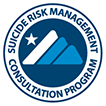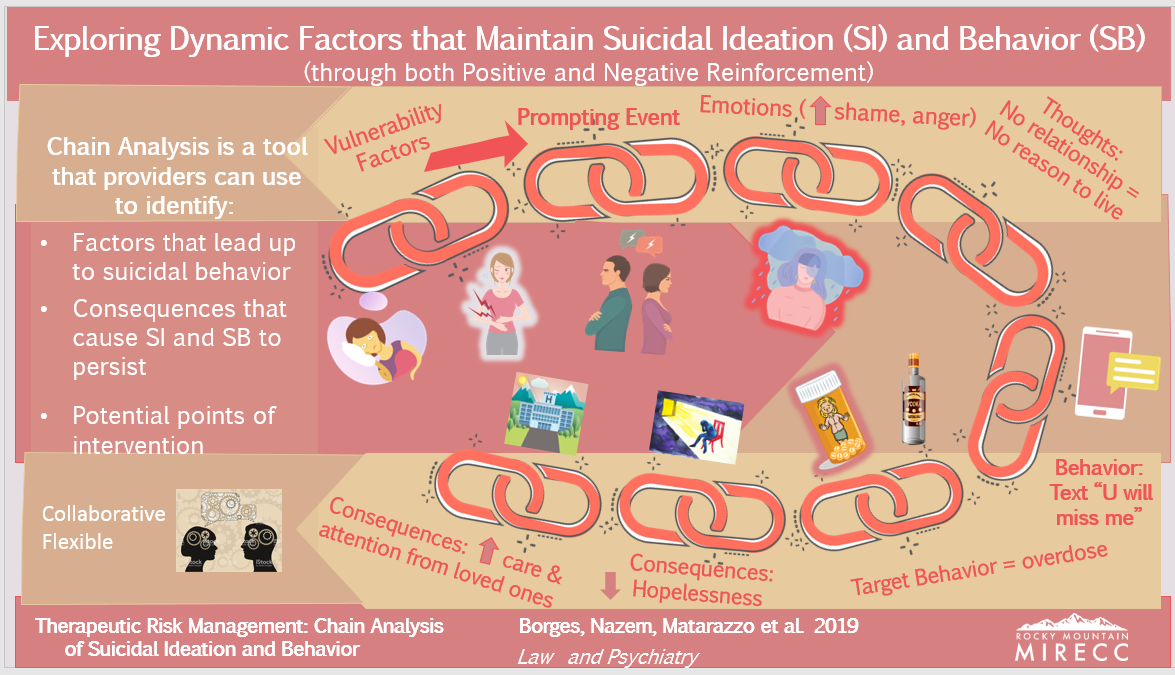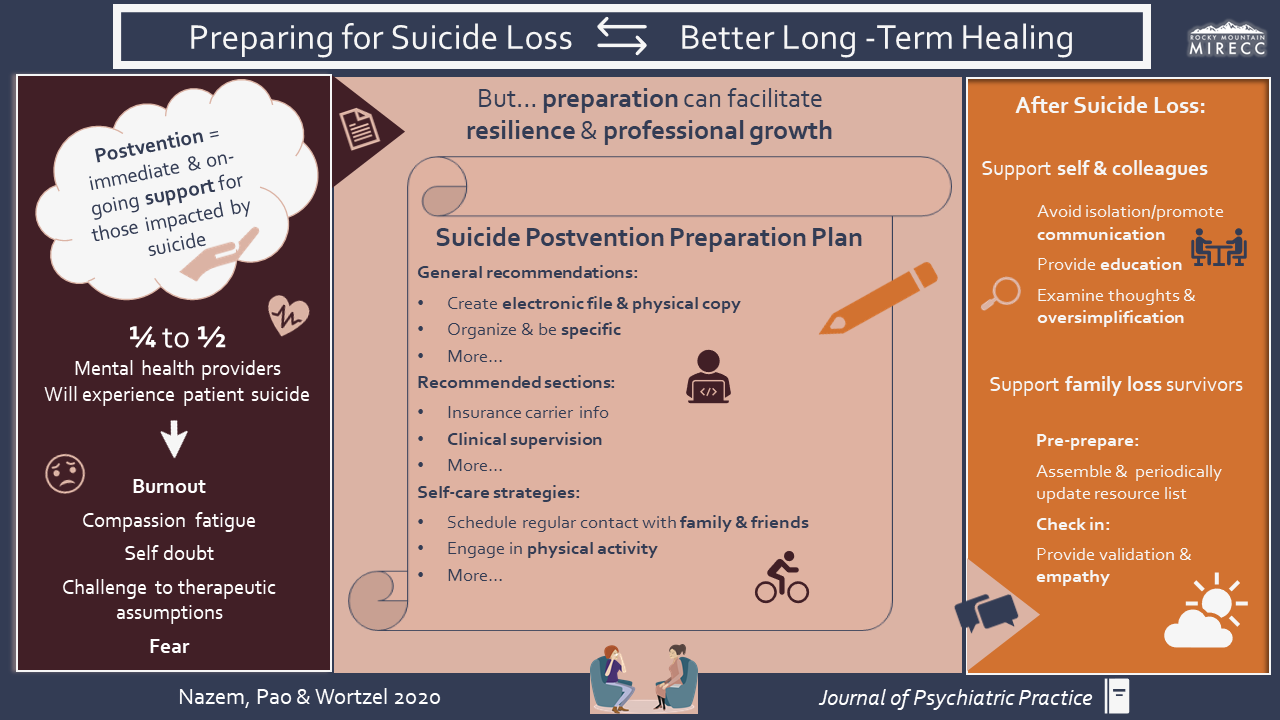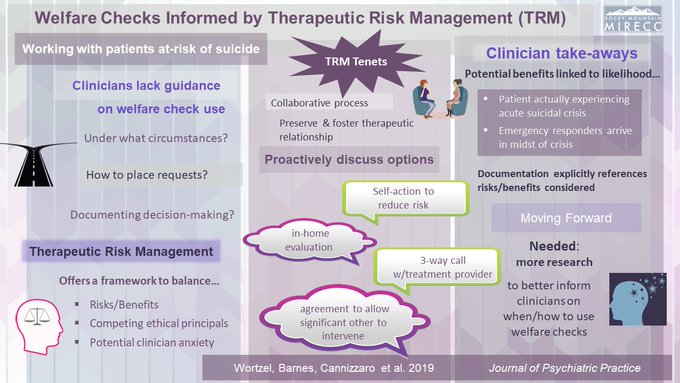Therapeutic Risk Management
 |
|||
 |
 |
 |
 |
Therapeutic Risk Management (TRM) with Patients at Risk for Suicide
The Rocky Mountain MIRECC model of Therapeutic Risk Management (TRM) with Patients at Risk for Suicide is a clinically, medically and legally informed model for the assessment and management of suicide risk. It is designed to be used collaboratively with the patients you serve. The model has evolved to include flexible elements to meet clients’ individual needs and clinical presentations, optimizing suicide risk assessment and management.
The original model involved three main components:
- Augmentation of clinical risk assessment with structured instruments
- Risk stratification with respect to both severity and temporality
- Collaborative development of a safety plan
More recent additions to the model include:
- Use of chain analysis to further explore the function of Veteran’s suicidal thoughts
- Lethal means safety guidance and recommendations
- Obtaining collateral data for support persons in the Veteran’s life
- Welfare checks as a part of therapeutic risk management
- Postvention planning and services for suicide loss survivors
The TRM model and its components are fully described in a series of ten articles published in the Journal of Psychiatric Practice. Read the articles in this series here.
Risk Stratification Table
Notice: The HTML, electronic PDF, and laminated print versions of the updated TRM Risk Stratification Table are all available for immediate use at the links below.
The Risk Stratification Table is a tool designed to:
- help providers make determinations regarding suicide risk levels with respect to severity and temporality
- aid in suicide risk management clinical decision making.
Visit the HTML version of the TRM Risk Stratification Table (Updated: May 2024)
Download the accessible PDF version of the TRM Risk Stratification Table (Updated: June 2024)
Order multiple laminated print copies for free from our Order Form.
Related Webinars
- Suicide Risk Assessment Matters presented by Drs. Hal Wortzel & Bridget Matarazzo
- Suicide Risk Stratification and Documentation presented by Dr. Hal Wortzel
- Safety Planning- Basics and Beyond presented by Drs. Megan Harvey & Suzanne McGarity
- Evidence-Based Practice in Suicide Risk Screening and Evaluation: Why, What, How, and When? presented by Dr. Nazanin Bahraini
- Using Chain Analysis to Assess and Intervene on Suicidal Ideation and Behavior presented by Drs. Sean Barnes & Lauren Borges
- Welfare Checks and Therapeutic Risk Management presented by Drs. Hal Wortzel & Edgar Villareal
- Lethal Means Safety: Evidence Base, Current Practices and Next Steps presented by Dr. Joseph Simonetti See links in Training section
- Perspectives on Firearm-Related Conversations in Clinical Settings presented by Dr. Joseph Simonetti
- A Patient-Centered Approach to Lethal Means Safety with Veterans presented by Drs. Ryan Holliday & Lindsey Monteith
- Suicide Postvention presented by Dr. Sarra Nazem
TRM Featured in National Suicide Prevention Guidance
Several national bodies, including VA/DoD and the Joint Commission, recommend therapeutic risk management:
Joint Commission National Patient Safety Goals (see NPSG.15.01.01 EP3) (Updated November, 2019)
VA Suicide Risk Management (SRM) Consultation Program
Providing care for Veterans at risk of suicide may feel like a daunting responsibility. Why worry alone? The Rocky Mountain MIRECC offers free, one-on-one consultation for any provider (community as well as VA) who works with Veterans.
Tools + Support + Evidence-based Knowledge = Better Outcomes
Ask for an SRM consult by emailing srmconsult@va.gov
Visit the SRM website.
Links to articles about TRM
- A Model for Therapeutic Risk Management of the Suicidal Patient
- Therapeutic Risk Management of the Suicidal Patient: Augmenting Clinical Suicide Risk Assessment with Structured Instruments
- Therapeutic Risk Management of the Suicidal Patient: Stratifying Risk in Terms of Severity and Temporality
- Why Suicide Risk Assessment Still Matters
- Therapeutic Risk Management of the Suicidal Patient: Safety Planning
- Therapeutic Risk Management: Chain Analysis of Suicidal Ideation and Behavior
- Welfare Checks and Therapeutic Risk Management
- Balancing Patient Care and Confidentiality Considerations in Obtaining Collateral Information
- Therapeutic Risk Management and Firearm-related Lethal Means Safety
- Therapeutic Risk Management: Suicide Postvention
The visual abstracts below outline findings from some of these articles. Click or tap each image and learn more.
Looking for Resources for Therapeutic Risk Management of Other-Directed Violence?
TRM also requires attending to risk for violence against others. Fortunately, the TRM approach can be repurposed to address this need, as described in a separate series. The version of the TRM model and its components are fully described in a series of five articles published in the Journal of Psychiatric Practice with links to articles here:
- Therapeutic Risk Management for Violence: Clinical Risk Assessment
- Therapeutic Risk Management for Violence: Augmenting Clinical Risk Assessment with Structured Instruments
- Therapeutic Risk Management for Violence: Stratifying Risk and Characterizing Violence
- Therapeutic Risk Management for Violence: Safety Planning for Other-directed Violence
- Therapeutic Risk Management for Violence: Chain Analysis of Other-Directed Violent Ideation and Behavior
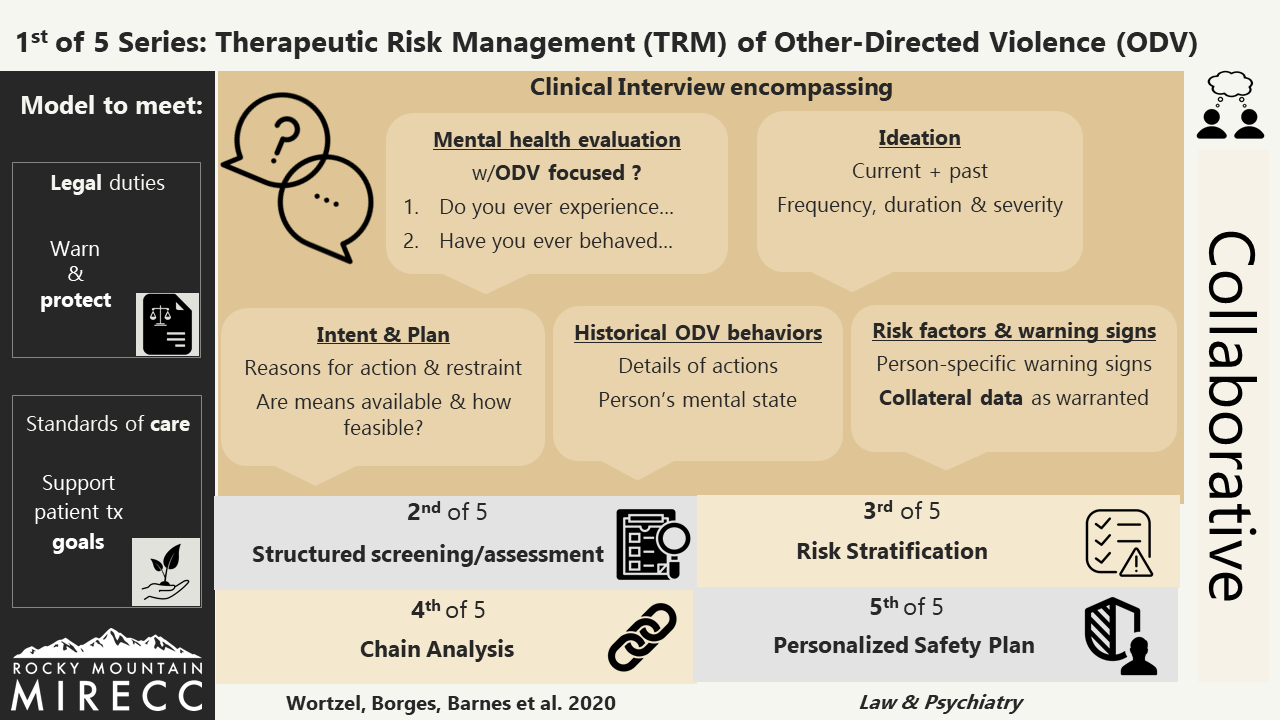 |
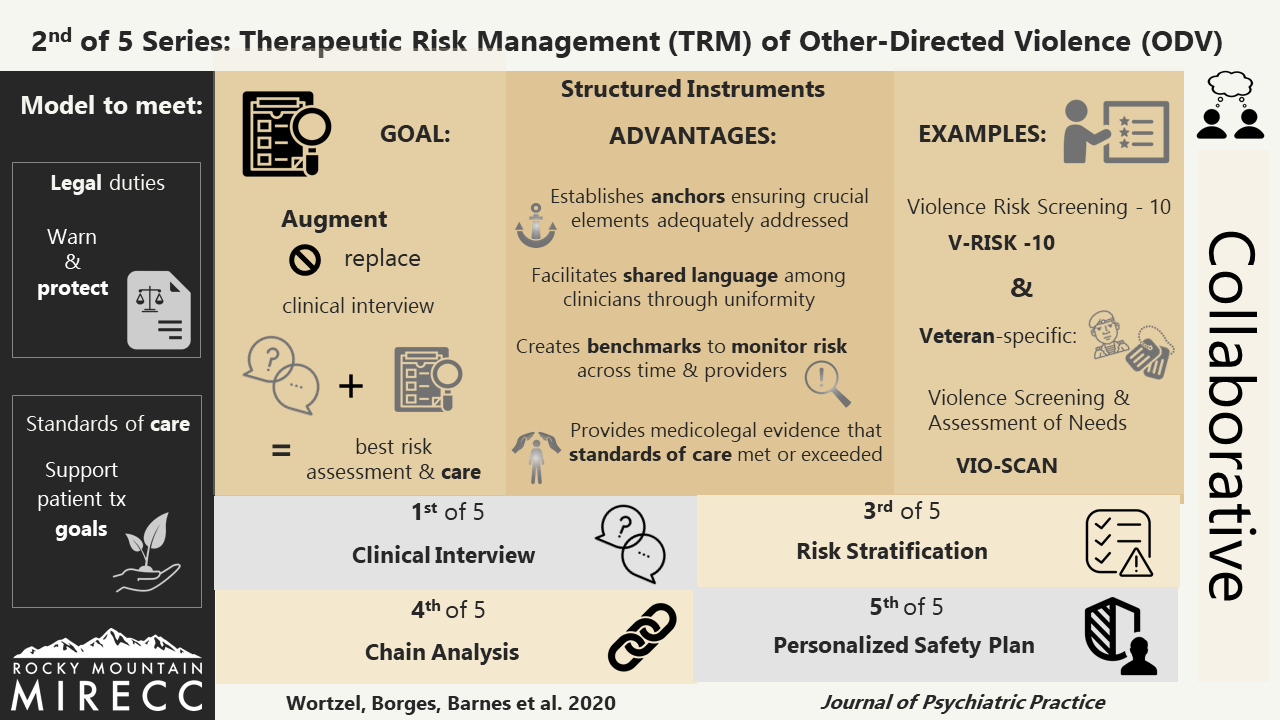 |
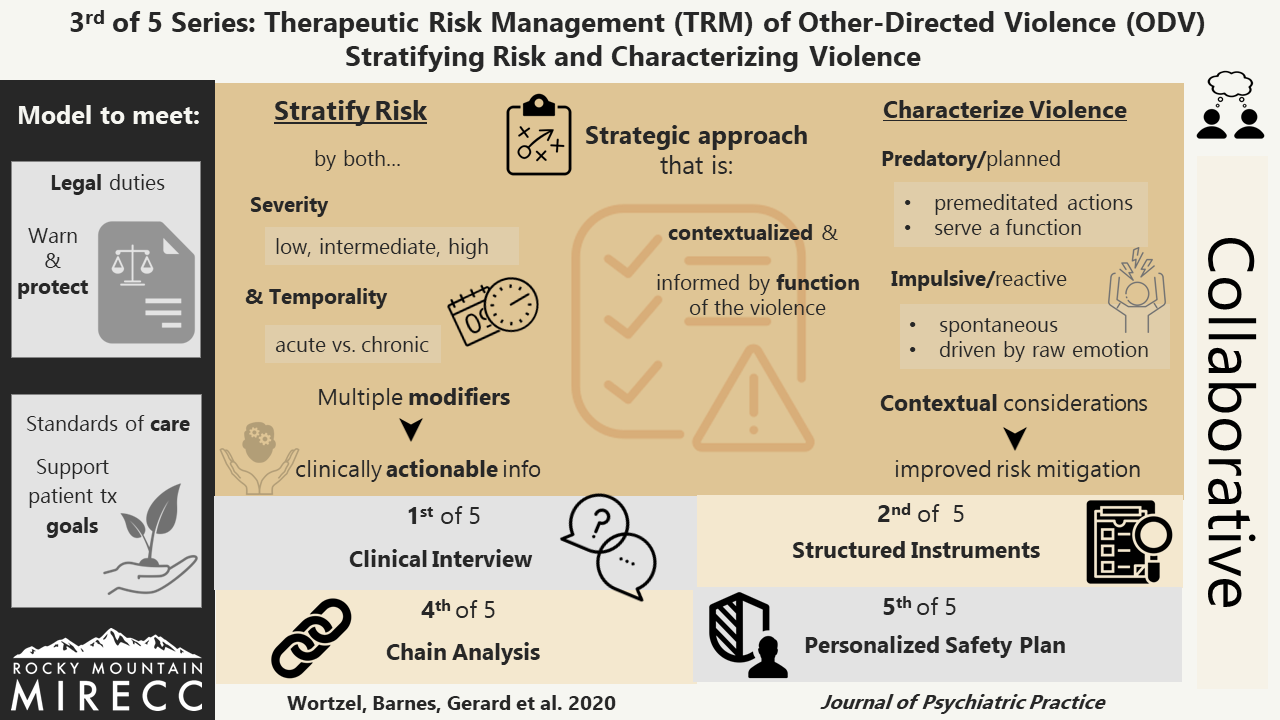 |
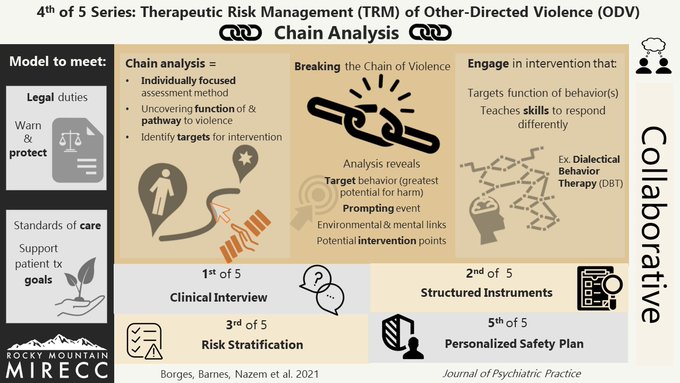 |
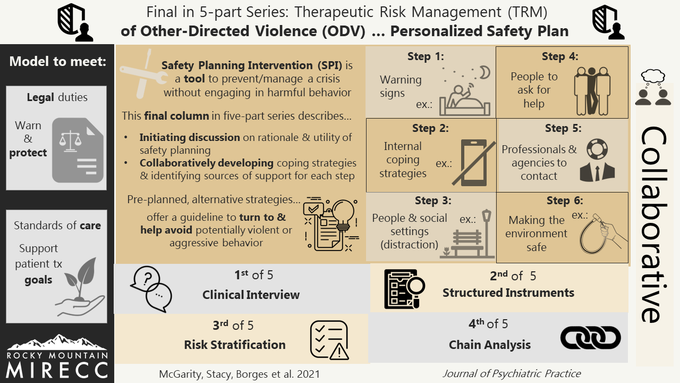 |
Last Updated 3 February 2025













